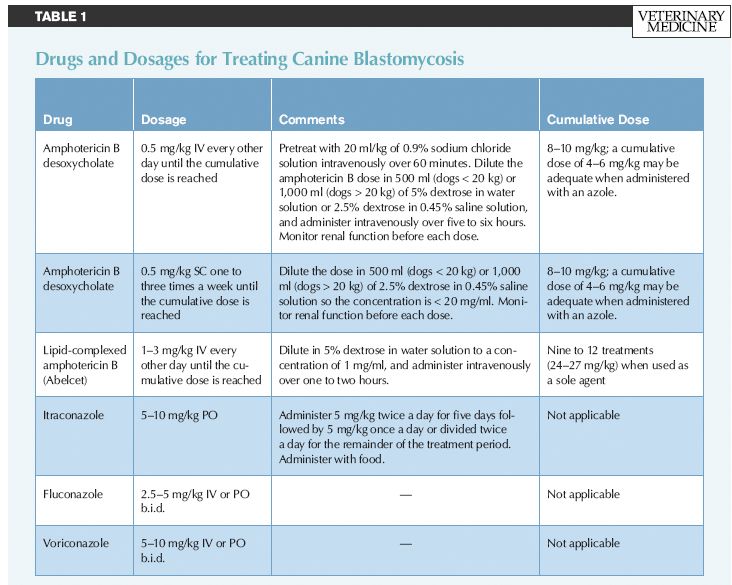
Blastomycosis in dogs: diagnosis and treatment
Blastomycosis caused by a type of fungus Blastomyces dermatitidis, primarily affects the eyes, lungs and skin. However, other organ systems, such as the bones, heart, central nervous system, and lymphatic system, can also be affected. How to detect blastomycosis in dogs?
Contents
Blastomycosis infection
Blastomycosis in dogs is not only common in certain geographic regions, but also requires a specific habitat. It is moist, acidic soil that contains rotting vegetation. The ideal environment for this fungus is beaver dams and swamps. Dogs that hunt birds and go hiking with their owners are at particular risk. But you should not think that other pets cannot get this disease. In areas of high prevalence, such as Wisconsin and Northern Illinois, this fungus can be found almost everywhere in the soil. It can even enter the house through dirt adhering to shoes and infect pets that do not leave their homes.
It is believed that infection of dogs with blastomycosis occurs mainly aerogenically, that is, by inhalation of soil aerosol contaminated with infectious particles – conidia. Certain weather conditions, such as dew, rain, and fog, activate these fungal particles, which are either inhaled or absorbed by the skin.
Blastomycosis Symptoms in Dogs
Symptoms of the disease may include one or more of the following, depending on which organ system is infected:
- increased body temperature;
- weight loss;
- poor appetite;
- cough;
- swollen lymph nodes;
- labored breathing;
- lameness;
- skin lesions, such as pimples and pustules, sometimes with fistulas, and various rashes.
Many dogs show signs of damage to several organ systems at once. According to DVM 360, 85% of pets experience coughing and difficulty breathing. Skin lesions and enlarged lymph nodes are observed in only 50% of patients. Lameness occurs in about 25% of cases when the bone is infected. In addition, signs of eye involvement are common, affecting about 50% of infected dogs.
Signs of Eye Damage in Blastomycosis in Dogs
Ocular blastomycosis in dogs tends to develop initially at the back of the eye. Tiny nodular foci of infection, so-called granulomas, affect the retina. This leads to its detachment and the development of the inflammatory process – chorioretinitis, that is, inflammation of the retina. Ultimately, this can lead to partial or total blindness, which may be irreversible, and eventually the need to remove the eye.
Subsequently, the fungus also affects the front of the eye. This leads to the development of more obvious signs of blastomycosis in dogs, including clouding, redness, pain, and swelling of the eye. Such signs occur, among other things, as a result of uveitis, that is, inflammation or glaucoma – increased pressure in the eye.
Diagnosis of blastomycosis
This disease can be very difficult to diagnose because its symptoms are often nonspecific. Skin lesions can often be mistaken for a simple skin infection, and bone or lung infections can look identical to certain types of cancer on imaging.
The diagnostic studies that the veterinarian will conduct will largely depend on which organ systems of the pet are affected by the disease. In most cases, he can start with a chest x-ray or a paw x-ray if the dog is lame. He can also examine tissue samples from a skin lesion under a microscope. Most often, fungal organisms are visible under a microscope, and this is enough to make a diagnosis.
However, in some cases, medical judgment may require the use of more advanced diagnostic tools, such as skin or bone biopsy. There is also an extremely reliable test for detecting traces of fungal organisms in the urine, samples of which can be sent to a specialized laboratory by a veterinarian.
Is canine blastomycosis transmitted to humans?
Under normal circumstances, pets cannot infect each other, people, or other animals. However, accidental needle sticks from aspirated dogs have led to skin infections in veterinarians. For this reason, people with open cuts or ulcers, and especially those with weakened immune systems, should use personal protective equipment when treating skin lesions topically. See the Centers for Disease Control and Prevention (CDC) website for more information about blastomycosisуpeople.
Fortunately, this infection is considered relatively rare in the human population. However, it is important to understand that domestic animals often serve as markers, that is, indicators of the presence of pathogens of this disease in the environment. Thus, if a dog becomes ill, it means that there is an active source of infection in the environment that puts the owner and any other pets in the house at risk. If a person has doubts about their own health, it is necessary to seek the advice of a specialist.
Treatment and prevention of blastomycosis in dogs
Fortunately, there are lines of antifungal drugs that can be used to treat this infection. However, treatment courses are often lengthy, at least 6–8 months, and antifungal medications can have serious side effects as well as high costs.
A dog may need to be hospitalized for a long time and even longer for pets with severe respiratory symptoms. In addition, the animal will need to take several different medications, depending on any complications caused by the infection. In the event of a severe bone infection, the dog may also require limb amputation.
The survival prognosis for pets with serious lung infections while in the hospital is 50/50, but it becomes more favorable when they return home.
Eye infections can be particularly difficult to treat and may require a consultation with a veterinary eye specialist. Topical eye medications can reduce the pain and discomfort associated with an eye infection, but usually do not cure the infection itself. Blastomycosis fungus often takes root in the eye and is difficult to get rid of. Thus, in some cases, it may be necessary to remove the infected eye, either because of irreversible loss of vision or to clear the infection from the body.
Dogs with blastomycosis are often discharged from the hospital with instructions for long-term oral or ophthalmic medications. Additionally, topical treatment of skin lesions and respiratory procedures, such as with a nebulizer, may be recommended.
Unfortunately, there is no vaccine to prevent blastomycosis in dogs. The best way to prevent this infection is to keep your dog away from wooded and swampy areas, especially when it snows or rains.
See also:
- What can you get from a dog
- Shortness of breath in dogs: when to sound the alarm
- Cough in a dog – we understand the reasons





